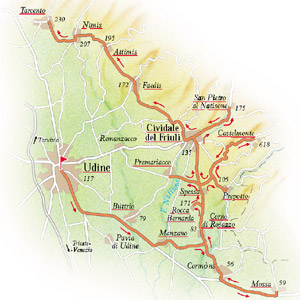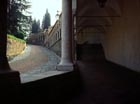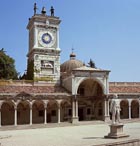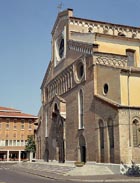A voyage round the Vines of Friuli
 The area where the great classic wines of Friuli are made is an irregular crescent shape about 10 kilometres from the regional capital, Udine. The tour starts in Udine itself, leaving the city to the south in the direction of San Giovanni al Natisone, and then proceeds, after passing through the important towns of Búttrio and Manzano, by a left turn to Corno di Rosazzo, then up past Spessa and continuing through Cividale del Friuli, Faedis, Nimis, finally to Tarcento. Along the way a brief diversion can be made east to Prepotto and the important vineyard area of Cialla.
The area where the great classic wines of Friuli are made is an irregular crescent shape about 10 kilometres from the regional capital, Udine. The tour starts in Udine itself, leaving the city to the south in the direction of San Giovanni al Natisone, and then proceeds, after passing through the important towns of Búttrio and Manzano, by a left turn to Corno di Rosazzo, then up past Spessa and continuing through Cividale del Friuli, Faedis, Nimis, finally to Tarcento. Along the way a brief diversion can be made east to Prepotto and the important vineyard area of Cialla.

Udine
 The city is built around a castle, in the heart of the Friulian plain between the Tagliamento and the Isonzo rivers. The transfer of the patriarchal seat from Cividale to Udine in the 13th c. turned it into the region’s cultural and artistic centre. In the late Middle Ages it was an important market for livestock and agricultural products and is now a lively industrial centre. Of the medieval period there remain only a few towers of the city wall and the churches of Santa Maria di Castello and of San Francesco, and parts of the cathedral. Nevertheless the city’s architecture is well known since it derived from its domination by Venice (15th–16th c.) which has left a legacy of fine Gothic and Renaissance buildings.
The city is built around a castle, in the heart of the Friulian plain between the Tagliamento and the Isonzo rivers. The transfer of the patriarchal seat from Cividale to Udine in the 13th c. turned it into the region’s cultural and artistic centre. In the late Middle Ages it was an important market for livestock and agricultural products and is now a lively industrial centre. Of the medieval period there remain only a few towers of the city wall and the churches of Santa Maria di Castello and of San Francesco, and parts of the cathedral. Nevertheless the city’s architecture is well known since it derived from its domination by Venice (15th–16th c.) which has left a legacy of fine Gothic and Renaissance buildings.
Castello
 The solid and imposing early 16th-c. fortification is built on the ruins of a previous castle belonging to the patriarchs of Aquileia. It owes its current appearance to Giovanni Fontana, and was renovated by Giovanni da Udine. It is reached through an arch known as the Arco Bollani, designed in 1556 by the architect Palladio, and via the salita al castello (ascent to the castle), flanked by a charming late 16th-c. Venetian-Gothic portico. After a long period of restoration following the 1976 earthquake the Ancient Art Gallery and the Archaeological Museum have reopened. The former is on the first floor, where the salone del Parlamento (Parliament Salon) is decorated with frescoes by Pomponio Amalteo and Tiepolo’s Triumph of the Christians over the Turks. There are paintings covering the period from the late Middle Ages to the late 19th c., including some by Tiepolo and Caravaggio, but the jewel in the crown is The Blood of Christ by another Venetian, Carpaccio. The Archaeological Museum, on the other hand, houses evidence of Friuli’s more distant past, from the Neolithic to the Lombard period.
The solid and imposing early 16th-c. fortification is built on the ruins of a previous castle belonging to the patriarchs of Aquileia. It owes its current appearance to Giovanni Fontana, and was renovated by Giovanni da Udine. It is reached through an arch known as the Arco Bollani, designed in 1556 by the architect Palladio, and via the salita al castello (ascent to the castle), flanked by a charming late 16th-c. Venetian-Gothic portico. After a long period of restoration following the 1976 earthquake the Ancient Art Gallery and the Archaeological Museum have reopened. The former is on the first floor, where the salone del Parlamento (Parliament Salon) is decorated with frescoes by Pomponio Amalteo and Tiepolo’s Triumph of the Christians over the Turks. There are paintings covering the period from the late Middle Ages to the late 19th c., including some by Tiepolo and Caravaggio, but the jewel in the crown is The Blood of Christ by another Venetian, Carpaccio. The Archaeological Museum, on the other hand, houses evidence of Friuli’s more distant past, from the Neolithic to the Lombard period.
Portico di San Giovanni
 This wonderfully elegant and impressive Renaissance structure was built in 1533 by Bernardino da Morcote. It is surmounted by the Clock Tower of 1527 which bears the lion of St. Mark (the patron saint of Venice) and two Moors who strike the hours, similar to those in St Mark’s Square in Venice. A wide arch in the centre allows access to the church of San Giovanni (St John), today a mausoleum dedicated to soldiers killed in battle. In the square in front of the portico are several statues, including a 17th-c. Justice, a 16th-c. lion of St Mark and a lovely fountain, the work of Giovanni da Carrara (1542).
This wonderfully elegant and impressive Renaissance structure was built in 1533 by Bernardino da Morcote. It is surmounted by the Clock Tower of 1527 which bears the lion of St. Mark (the patron saint of Venice) and two Moors who strike the hours, similar to those in St Mark’s Square in Venice. A wide arch in the centre allows access to the church of San Giovanni (St John), today a mausoleum dedicated to soldiers killed in battle. In the square in front of the portico are several statues, including a 17th-c. Justice, a 16th-c. lion of St Mark and a lovely fountain, the work of Giovanni da Carrara (1542).
Duomo
 Of the original 14th-c. Gothic building, remodelled in the 18th c., it retains the imposing structure, the central portal with splayed jambs crowned with a pinnacle, and the unfinished bell-tower, built on the octagonal 14th-c. baptistery. The interior has a nave and two aisles and is decorated with stuccowork, statues and baroque paintings. Worthy of note are the works of the 18th-c. Venetian painter Tiepolo decorating the altars of the south chapels with representations of the Trinity, Saints Ermagora and Fortunato and of the Resurrection. The high altar is a masterpiece of marble and is decorated with statues (1717).
Of the original 14th-c. Gothic building, remodelled in the 18th c., it retains the imposing structure, the central portal with splayed jambs crowned with a pinnacle, and the unfinished bell-tower, built on the octagonal 14th-c. baptistery. The interior has a nave and two aisles and is decorated with stuccowork, statues and baroque paintings. Worthy of note are the works of the 18th-c. Venetian painter Tiepolo decorating the altars of the south chapels with representations of the Trinity, Saints Ermagora and Fortunato and of the Resurrection. The high altar is a masterpiece of marble and is decorated with statues (1717).
Cividale del Friuli
 Located in the valley of the Natisone river, this was one of the largest towns in Friuli in the Middle Ages. In 568 Alboino made the town the capital of the first dukedom of Lombardy and it is from this period that it preserves evidence of its glorious past. The 16th-c. Palazzo dei Provveditori Veneti (Palace of the Venetian Governors) houses the National Archaeological Museum, which has one of the largest and most complete exhibitions on the Lombards in Italy. The cathedral, begun in 1453, was completed in the middle of the 16th c. by Pietro Lombardo. It houses the magnificent silver-gilt altarpiece with Madonna, saints and the patriarch Pellegrino II (1193–1204). Near the Natisone river is the 8th-c. Tempietto Longobardo, with splendid frescoes (11th c.) and plasterwork (8th–11th c.) including the six famous female figures in high relief.
Located in the valley of the Natisone river, this was one of the largest towns in Friuli in the Middle Ages. In 568 Alboino made the town the capital of the first dukedom of Lombardy and it is from this period that it preserves evidence of its glorious past. The 16th-c. Palazzo dei Provveditori Veneti (Palace of the Venetian Governors) houses the National Archaeological Museum, which has one of the largest and most complete exhibitions on the Lombards in Italy. The cathedral, begun in 1453, was completed in the middle of the 16th c. by Pietro Lombardo. It houses the magnificent silver-gilt altarpiece with Madonna, saints and the patriarch Pellegrino II (1193–1204). Near the Natisone river is the 8th-c. Tempietto Longobardo, with splendid frescoes (11th c.) and plasterwork (8th–11th c.) including the six famous female figures in high relief.
Tarcento
This holiday resort is situated amongst orchards and vineyards irrigated by the waters of the Torre in the valley of the Tagliamento river. It was almost completely destroyed by the 1976 earthquake but has restored the evidence of its historic past, including the 18th-c. Palazzo Frangipane and the parish church of San Pietro, originally built in the 12th c. but rebuilt in the Baroque period. Nearby are the caves known as the Grotte di Villanova, which are of interest to speleologists.
|
THE PLEASURES OF THE TABLE |
|
| Muset con broade | Prosciutto San Daniele |
| One of the classic dishes of Friulan cuisine. Muset in this case refers to the traditional cotechino (boiled sausage), made out of both the fatty and the lean parts of the pig, including head and skin, finely minced and mixed with spices and flavourings, stuffed into a natural casing. Use: boiled and traditionally served with “broade”, a type of sauerkraut. | Famous throughout Italy, this air-cured ham is aged for between 15 and 18 months. The town of San Daniele celebrates its most famous product on the fourth Sunday in August with tastings of prosciutto and snacks of salami, sausages and cotechini boiled sausage washed down with excellent Friulan wines. Use: as well as the classic summer dish of prosciutto with melon or figs, also excellent in the “portafogli San Daniele” (San Daniele wrap) comprising a slice of meat folded in half holding a slice of prosciutto, a slice of Montasio cheese, and a roast sweet pepper. |
| Gubana di Cividale | Montasio |
| A dessert made with puff pastry filled with ground nuts, zibibbo sweet wine, sultanas soaked in rum, pine nuts, chocolate pieces, chopped figs and prunes, and candied verbena, all bound together with egg yolks. Usually baked in the form of a strudel-type roll. | Friuli’s most traditional cheese takes its name from the mountain plain of Montasio, set amongst the alpine peaks on the northeastern borders of the region. |
|
THE WINE |
| The region of Friuli is characterized by a modern, high quality production of wine that was already quite developed by the middle of the last century. It is reknowned, above all, for the production of white wines of excellent quality. Along with the traditional autoctono vines Tocai Friulano, Verduzzo Friulano, Refosco dal Peduncolo Rosso and the rare Picolit, we also find important French and German varieties such as Merlot, Cabernet, Chardonnay, Sauvignon, Traminer Aromatico and Riesling Renano. Let's take a look at the principle vineyards. If you would like to prepare a lunch or dinner reminiscent of the area, click here to purchase wines carefully selected by our experts. |
|
EATING AND SLEEPING |
| In Udine we suggest you to stop at Al Lepre (tel. +39 0432295798), one of the oldest tavern of the city: good food and excellent wines at reasonable prices. In Cividale del Friuli a good stop is the "enoteca" Il Cantiniere Romano (tel. + 39 0432732033) where you can have a wide choice of local wines and taste the hot dishes prepared by Marisa: gnocchi with ricotta and spinach, risotto with yellow pumpkin, "parmigiana" tripe and several others. To sleep we suggest you Locanda al Castello in Cividale del Friuli (tel. +39 0432733242), few nice and quite rooms inside a eighteenth century castle. In Udine a good address is the hotel Clocchiatti (tel. +39 0432505047), confortable rooms located in a eighteenth century liberty-style villa. |








